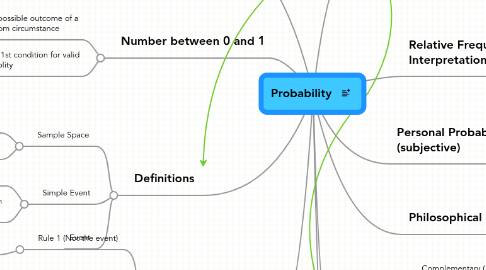
1. Number between 0 and 1
1.1. The possible outcome of a random circumstance
1.2. Meets 1st condition for valid probablity
2. Uses percentages based on proportions of individuals
3. Definitions
3.1. Sample Space
3.1.1. With Replacement
3.1.2. Without Replacement
3.2. Simple Event
3.2.1. Sum of all Simple Events = 1
3.2.2. If equally likely then probability = 1/k
3.3. Event
4. Rules for Finding Probabilities
4.1. Rule 1 (Not the event)
4.1.1. Probability an event does not occur
4.1.1.1. P(A)+P(A^c)=1
4.2. Rule 2 (Addition)
4.2.1. Probability that either of two events happens
4.2.1.1. Rule 2a (general)
4.2.1.1.1. P(A or B)=P(A)+P(B)-P(A and B)
4.2.1.2. Rule 2b (mutually exclusive events)
4.2.1.2.1. P(A or B)=P(A)+P(B)
4.3. Rule 3 (Multiplication)
4.3.1. Probability that two or more events occur together
4.3.1.1. Rule 3a (general)
4.3.1.1.1. P(A and B)=P(A)PB|A)=P(B)PA|B)
4.3.1.2. Rule 3b (independent events)
4.3.1.2.1. PA and B)=P(A)P(B)
4.3.1.3. Rule 3b (extension)
4.3.1.3.1. P(A1 and A2...and An)=P(A1)P(A2)...(PAn)
4.4. Rule 4 (Conditional Probability)
4.4.1. Determining a conditional probability
4.4.1.1. P(B|A)=P(A andB)/P(A)
5. Random Circumstance
5.1. outcome not determined until we see it
5.2. Outcome already determined but our knowledge is uncertain
6. Relative Frequency Interpretation
6.1. Make assumption about Physical world
6.2. Make direct observation of how often something happens over many, many repetitions of the situation.
7. Personal Probability (subjective)
7.1. Degree an individual believes it will happen
7.2. Coherent (no contradiction)
8. Events
8.1. Complementary ("Opposite")
8.2. mutually exclusive (disjoint)
8.3. Independent
8.4. Dependent
8.5. Conditional Probablity
8.5.1. P(B|A) = probability of B given A
9. Philosophical Issue
9.1. Outcome has been determined but is still unknown
9.2. Confidence vs Probability
10. Strategies
10.1. Bayes Rule
10.1.1. P(A|B)=P(A and B)/PB|A)P(A)+P(B|A^c)P(A^c)
